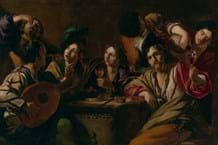American architect Mary Jane Long (1939-2018) ran her own practice in London and, with Sir Colin ‘Sandy’ St John Wilson, was also half of the notable husband-and-wife team of architects who were the principal design partners for the British Library project.
Home and office
The consignment included a wide variety of modern furniture, fine art and personal pieces from the couple’s home and their office.
From the latter came the top-seller at the auction on January 28: a pair of Alvar Aalto Beehive lamps. The 13in (32cm) diameter A331 lamps were designed in 1953 for Valaistustyö Ky and stamped accordingly. Estimated at £400-600, they sold to a Scandinavian bidder at £5000.
The couple’s admiration for Sir Eduardo Paolozzi, who would provide the bronze for the forecourt at the British Library, was reflected in a dozen offerings led by a 1960 mixed media and collage Study of a Figure (see Art Market, page 29).
Charles Rennie Mackintosh was another favoured name, albeit represented by copies made by the Anglo-Italian firm Cassina. Top piece among these was a Willow chair which more than doubled expectations at £800.
Personal items echoed MJ Long’s North American roots. A 3ft 9in (1.15m) tall painted wooden doll’s house she made and designed after a classic New Haven Connecticut home sold for £310 and a 14ft 4in (4.38m) long Canadian cedarwood canoe took £2000.

Table lamps stamped Tiffany Studio New York – £3900 at Sworders.
Elsewhere in the 780-lot specialist sale, lighting material was again to the forefront.
Estimated at £1000-1500 was a near pair of bronze and favrile glass Art Nouveau-style lamps stamped Tiffany Studio New York and numbered 317 and 319.
The pair sold to a UK private buyer at £3900.
Alvar Aalto’s Model 31 cantilever chair is also now among the most familiar of shapes but it represented a design breakthrough when designed for a TV sanitorium in Finland in 1931. Lightweight, economical, and comfortable, it was made using laminated plywood instead of tubular steel.
In production for years, the example on offer, with a label reading Finmar Ltd Design Rec 787811-19 made in Finland, was a post-war piece. Pitched at £1500- 2000, it attracted Scandinavian interest before selling to a US bidder for £3800.
The short-lived Italian designer and artist Cesare ‘Joe’ Colombo (1930-71) was represented by an Elda black leather armchair swivelling on a white fibreglass shell, which he designed in 1963 for Comfort Italy. It doubled Sworders’ estimate at £2900.
American Maurice Bailey’s 8ft (2.42m) wide walnut and black leather sofa, another favourite of the Swinging Sixties, went further above hopes.
Designed c.1960 for Bailey’s long-time associates Monteverdi-Young, it had the original label for the Los Angeles firm on the underside. It was estimated at £1000-1500 and sold at £3700.
Both pieces seem destined to be viewed at some point by a wider public than merely the designers’ aficionados – they sold as props to a film and television company.
Sofa so good
Italian and American furniture enjoyed further success.
From Italy, an 8ft (2.5m) Soriana sofa by the wife-and-husband team Afra (1937-2010) and Tobia Scarpa (b.1937) was designed in 1970 for Cassina. It was pitched at £800-1200 and sold to a Continental buyer at £3300.
A walnut dresser branded Lane Altavista Virginia bore the hallmarks of the US company’s mid-20th century ‘Brutalist’ line in the style of Paul Evans, with blockwork fronts to the six drawers flanking a central cupboard.
Undated in the catalogue, the 6ft 4in wide x 2ft 6in high (1.99m x 78cm) dresser sold to a UK private buyer at £2650.
















